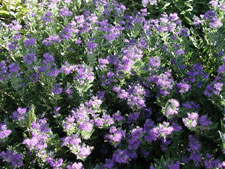Resource Library
Plant of the Week: Bluebeard
The University of Arkansas System Division of Agriculture does not promote, support or recommend plants featured in "Plant of the Week." Please consult your local Extension office for plants suitable for your region.
Plant of the Week
Bluebeard
Latin: (Caryopteris x clandonensis)

Butterflies have become an important consideration for many gardeners, so the plants chosen for flowery borders often reflects this interest. One of the best for attracting butterflies and bees in late summer and fall is bluebeard, Caryopteris x clandonensis.
Bluebeard, or as sometimes called blue spirea, is a dieback shrub; a plant with a cold-hardy, woody base and tender branches. It grows as far north as Chicago where plants can reach three feet tall and wide by summer’s end, but the slender stems at the top freeze back during the winter.
The inch-long elliptic, opposite leaves are green, gray or golden, according to the cultivar. Blue, lavender or purple flowers are borne in terminal or axillary cymes in late summer and fall. The five petals of the flowers are short lived, but the protruding stamens persist and give flowering plants a kind of bearded look.
The 16 Caryopteris species are members of the verbena family with all native to southeastern Asia. China is home to 14 Caryopteris including C. incana and C. mongholica, the two species used to create the hybrid species. The former species is more frost tender and native to southeastern China, while the latter is native to colder regions of north central and western China.
The cold-hardy Caryopteris from Mongolia was introduced during Pere David’s third and final expedition (1872-1874) into unexplored parts of China northwest of Beijing. Father David was a Jesuit priest from France whose assignment was to study the natural history of the country, because to know nature was to glorify God. He introduced many natural history marvels to the West with the giant panda his most famous.
The hybrid bluebeards were first mated by Arthur Simmonds, the long time Secretary of the Royal Horticultural Society in England. He made the cross in 1933 in his garden in Surrey with the still-commercially-produced cultivar ‘Arthur Simmonds’ the result. Since 1990 and the revival of the new plant craze, much breeding effort has been devoted to these plants and a number of new introductions are now offered. ‘Azure,’ ‘Kew Blue,’ ‘Ferndown’ and ‘Dark Knight’ are more compact or darker-colored versions of the original.
Gray-green leafed selections of the hybrid include ‘Longwood Blue’ and ‘Blue Knoll.’ ‘Worcester Gold’ was the first of the golden leafed cultivars offered. It’s bright chartreuse in the spring, fading a bit later in the season. ‘Summer Sorbet’ is a golden variegated mutant of ‘Kew Blue.’ ‘Sunshine Blue’ and ‘Hint of Gold’ are golden-leafed selections of C. incana that are less cold tolerant (zone 7) than the more common hybrid.
Caryopteris are tough, drought-tolerant plants that do best in sunny sites with good, well-drained soil. They flower on new growth each spring, so the easiest way to ensure good flowering is to cut plants back to stubs in late winter. They require moderate to heavy fertilization to ensure heavy flowering in late summer. Pinching the new growth in late spring will encourage fuller, more compact plants when the blooms appear in August. Bluebeards tend to stop flowering if not periodically tipped back in late summer to encourage new growth.
Bluebeards are good for massing in areas where plants have to fend for themselves during the summer months. They can also be added to the mixed border, but they’re not especially competitive with vigorous neighbors so give them room to grow without crowding. Propagation is easy by softwood cuttings in the spring.
By: Gerald Klingaman, retired
Extension Horticulturist - Ornamentals
Extension News - October 31, 2008
The University of Arkansas System Division of Agriculture does not maintain lists of retail outlets where these plants can be purchased. Please check your local nursery or other retail outlets to ask about the availability of these plants for your growing area.